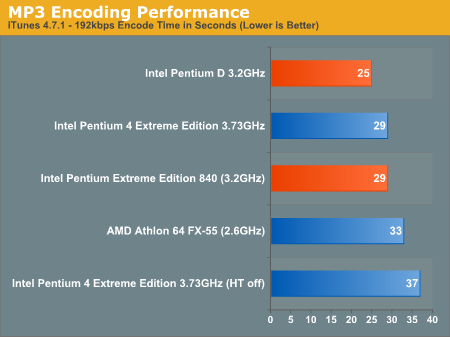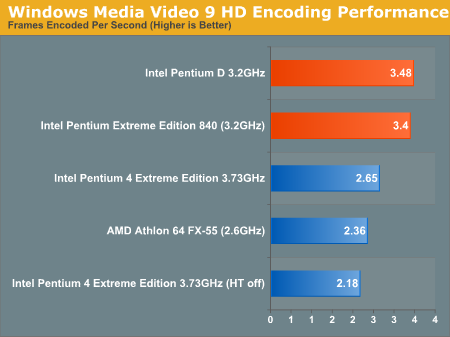Intel Dual Core Performance Preview Part I: First Encounter
by Anand Lal Shimpi on April 4, 2005 2:44 PM EST- Posted in
- CPUs
Encoding Performance
These new dual core CPUs are supposed to usher in a new era of media rich application usage models. They are supposed to enable us to do things that we were never able to do before. Let's find out if that's true or not...
First, we start off with iTunes to test MP3 encoding performance. We took a 12MB .wav file of our own creation and encoded it to a 192kbps MP3 file, measuring how long it took to encode the file.

Once again, we see that the Pentium Extreme Edition 840 is able to offer equal performance to the 3.73EE at 29 seconds. What's truly interesting is that the Pentium D running at 3.2GHz actually offers better performance than the Extreme Edition. We can only assume that 4 threads in iTunes begins to reduce performance, with 2 concurrent threads being the optimal point.
But once again, the performance gains aren't impressive. So far, dual core isn't looking too good.
DivX Encoding Performance
Our DivX tests from previous CPU reviews have shown a pretty sizeable improvement due to Hyper Threading, so we expected a similarly impressive gain due to dual core:

...and we were not disappointed. The Pentium Extreme Edition 840 offered more than a 20% increase in performance in our DivX encoding task when compared to the 3.73GHz single core P4 Extreme Edition.
We also see another example of four threads offering no performance improvement over being able to execute two concurrently, as the Pentium D running at 3.2GHz offers equal performance to the 840.
XviD Encoding Performance

The XviD tests show no real improvement due to dual core, but also don't seem to show much of an improvement due to Hyper Threading either. This just goes to show you that not all encoding tasks will show tremendous benefits.
Windows Media Video 9 Encoding Performance
Once again, we see extremely strong performance from the new dual core chips, offering around a 30% performance improvement at 85% of the clock speed of the current king of the hill.

So, overall encoding performance is pretty strong on the dual core chips from Intel. Let's have a look at one more multi-threaded application before we get to the more interesting tests.










141 Comments
View All Comments
Pandaren - Tuesday, April 5, 2005 - link
Drat. Double Post. Where's the gaming benchmarks? And are those multitasking scenarios realistic? I don't think I would ever do all that at once.Pandaren - Tuesday, April 5, 2005 - link
sideshow23bob - Monday, April 4, 2005 - link
Additionally, what about throwing in Nero,DC++, azureus, bitcomet, and/or Power DVD. Just progs. that alot of typical college-aged users use(i can verify at least). Great article. Loved the multitasking analysis especially.sideshow23bob - Monday, April 4, 2005 - link
ravedave - Monday, April 4, 2005 - link
Anand, what about DVDDecrypt and DVDShrink at the same time (as in decrypting one movie, shrinking another)? Dual core could really make ripping faster if you could do both of those at once...ViRGE - Monday, April 4, 2005 - link
#44, SETI is a really good idea, not just because of heat but because it'll push the memory/FSB at the same time. If Intel's chips are getting choked, SETI should scream pretty loudly by tanking in performance.nigham - Monday, April 4, 2005 - link
Thanks, this was a real nice review and its got me all excited. One thing I'd really like to know, though, how does Linux handle dual-core? Does it show the same kind of multi-tasking performance boost that we see on Windows XP? I mostly use Linux for my work and I do a ton of multitasking. Windows I use only for gaming, which as you point out are mostly single threaded applications.gregwjones - Monday, April 4, 2005 - link
Dual-core benchmarks I'd like to see:Two instances of Seti@Home, BOINC version, run on a Pentium D 3.2GHz( dual-core, but no HT )
compared to Pentium 4 3.2GHz single core with HT.
Then run four instances of SETI@Home on the Pentium EE ( dual-core with HT ).
This should generate a lot of heat and put everything at max load.
I have a Pentium 4 Northwood with HT enabled and run two instances of BOINC Seti@Home while using the system to do everyday tasks.Like web browsing, DVD Decrypt, DVD Shrink. Everything is very responsive because BOINC runs at a very low priority.
dragonballgtz - Monday, April 4, 2005 - link
Great article! It's a good thing you did not do a review like all of the other sites. With just some benchmarks and a few games.As always I can't wait to read more reviews form you Anand. :thumbsup;
shabby - Monday, April 4, 2005 - link
The multi-tasking numbers are definetly intresting, but any sane person will wait and see what amd has up its sleeve.